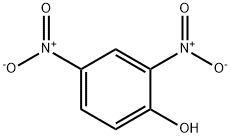2,4-Dinitrophenol suppliers
2,4-Dinitrophenol
- CAS:
- 51-28-5
- MF:
- C6H4N2O5
- MW:
- 184.11
Properties
- Melting point:
- 108-112 °C (lit.)
- Boiling point:
- 318.03°C (rough estimate)
- Density
- 1,683 g/cm3
- vapor density
- 6.35 (vs air)
- vapor pressure
- 39(x 10-5 mmHg) at 20 °C (Schwarzenbach et al., 1988)
- refractive index
- 1.4738 (estimate)
- Flash point:
- 11 °C
- storage temp.
- 2-8°C
- solubility
- Solubility Sparingly soluble in water; soluble in ethanol, benzene
- form
- crystals
- pka
- 3.96(at 15℃)
- color
- Light yellow
- PH Range
- 2.8(colourless)-4.7(yellow)
- Odor
- Sweet, musty
- Water Solubility
- 0.6 g/100 mL (18 ºC)
- Sensitive
- Light Sensitive
- Merck
- 14,3280
- BRN
- 1246142
- Henry's Law Constant
- 5.70 x 10-8(atm?m3/mol) at 5 °C (average derived from six field experiments, Lüttke and Levsen, 1997)
- Stability:
- Stable. Combustible.
- Major Application
- Display device, recording materials, inks, paints, method for preserving food, method for gene expression profiling, treatment of parasitic diseases, neurological diseases, epilepsy, cancer, keratin materials, neoplasms, infectious diseases, neutropenia, detecting chromosome aberrations, bacteria in gastrointestinal track
Safety Information
- Symbol(GHS)




GHS02,GHS06,GHS08,GHS09
- Signal word
- Danger
- Hazard statements
- H208-H300-H311+H331-H372-H400
- Precautionary statements
- P210-P212-P230-P233-P280-P301+P310-P371+P380+P375-P501
- Hazard Codes
- T,N,Xi,F
- Risk Statements
- 23/24/25-33-50-39/23/24/25-11-52/53-1
- Safety Statements
- 28-37-45-61-28A-36/37-16-7-35
- RIDADR
- UN 1320 4.1/PG 1
- WGK Germany
- 3
- RTECS
- SL2800000
- TSCA
- Yes
- HazardClass
- 4.1
- PackingGroup
- I
- HS Code
- 29089990
- Toxicity
- LD50 (subcutaneous) for rats 25 mg/kg (quoted, RTECS, 1985).
Use
The bacterial strain RB1, which is isolated by enrichment cultivation with 2,4-dinitrophenol, degrades this phenol into two aliphatic acids. One metabolite results from the release of the 2-nitro group as nitrile, with the production of aliphatic nitro compound, 3-nitroadipate. Then, the 3-nitro group is released from this metabolite as nitrile. The other metabolite is 4,6-dinitrohexanoic acid possessing two nitro groups from 2,4-dinitrophenol.
According to relevant laws, regulations, policies and the provisions of this website, this website does not display the product information!
The source is "易制爆、炸药、化学武器等". If the information is inaccurate, please contact the platform to modify it.
contact information:info@chemicalbook.com 400-158-660


